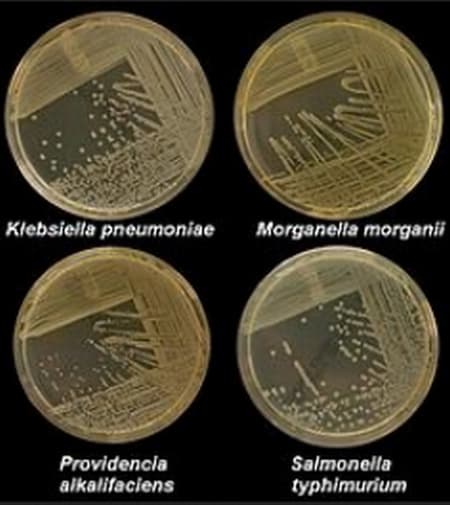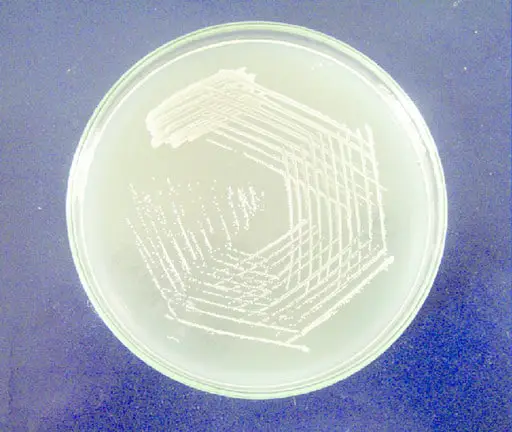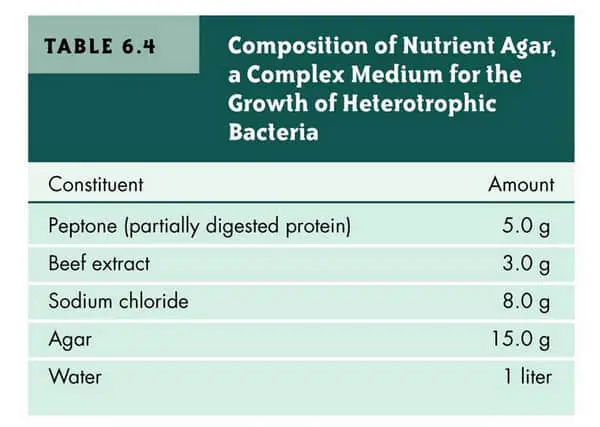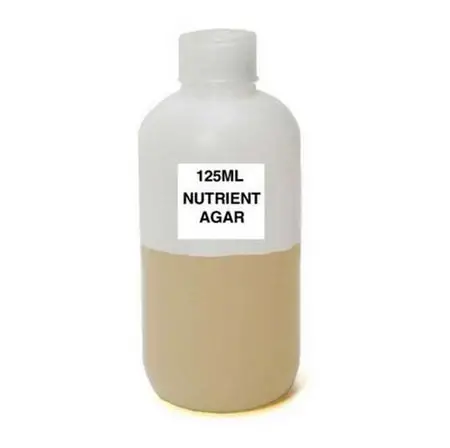Agar is a complex polysaccharide. It is highly valuable to microbiologists, although it provides no nutrient support for bacteria. It is commonly used in the laboratory setting primarily because of the following reasons:
- It remains solid and only a few microbes can degrade it.
- It will remain solid until it reaches 100 degree Celsius. Once it is liquefied, it will remain liquid until the temperature reaches 40 degree Celsius.
- It has the ability to remain solid even at a high temperature, which makes it perfect for growing heat-loving bacteria. (1, 2, 3, and 4)

Image 1: Four Petri dishes with nutrient agar used as a medium. Four types of bacteria are being tested for growth in nutrient agar.
Picture Source: wikimedia.org

Image 2: A Petri dish with a colony of Klebsiella on nutrient agar.
Picture Source: researchgate.net
What is a Nutrient agar?
It is a general purpose agar; specifically, a nutrient medium primarily used for cultivating microbes and support the growth of a huge array of non-selective organisms. It is the most popular type of agar because of its ability to grow a variety of bacteria and fungi. It contains the essential nutrients needed for growing bacteria.
Nutrient agar is a complex media. It is perfect for growing non-selective heterotrophic bacteria. Such bacteria cannot make their own food and are not selective when it comes to their food sources. Many disease-causing bacteria are non-fastidious. Nutrient agar, being a complex media, is the ideal medium for growing and cultivating bacteria. (3, 4, 5, and 6)

Image 3: The compositions of nutrient agar.
Picture Source: slideplayer.com

Image 4: Nutrient agar as a growth medium.
Picture Source: bigcommerce.com
Components of Nutrient agar
- Beef extract – it is derived from tissues of lean beef (aqueous extract). It has water-soluble substances of animal tissues like organic nitrogen compounds, salts, carbohydrates, and water-soluble vitamins.
- Peptone – it is an enzymatic digest of animal proteinaceous materials such as animal protein, casein, and gelatin using enzymes or acids. It is the main supply of organic nitrogen for growing bacteria. It may contain vitamins and carbohydrates.
- Agar – it is the solidifying agent.
- Sodium chloride – it is responsible for maintaining salt concentration in the medium. It functions the same way as the cell’s cytoplasm.
- Distilled water – It is needed for the organisms to grow and reproduce. Through water, nutrients can be transported. (3, 6, 7, and 8)
Note: pH is adjusted to neutral at 25 °C.
What are the uses of nutrient agar?
- It is used to isolate and purify cultures.
- It is used as a means for the production of bacterial lawns necessary for an antibiotic sensitivity test.
- It is used to cultivate and maintain non-fastidious microorganisms.
- It aids in enumerating microorganisms in water, dairy products, sewage, feces, and other types of materials. (3, 9, and 10)
How to prepare the Nutrient agar?
- Prepare about 28 grams of nutrient agar powder. Suspend it in a liter of distilled water.
- Bring the mixture to heat making sure you constantly stir the mixture to totally dissolve all its components.
- Once the mixture is fully dissolved, the next step is to an autoclave for 15 minutes at 121 degree Celsius.
- Once autoclave is complete, let the medium rest. The purpose is to cool it down and not solidify.
- Pour the agar into the plate making sure you put the plate on a sterile surface. Leave it there until such time it solidifies.
- Put the lid of the Petri dish and place inside the refrigerator. (1, 4, 7, and 9)
Quality Control
- One of the important things to check is the color of the prepared nutrient agar. The expected color should be light amber.
- The pH of the medium should be 6.8 ± 0.2.
- The performance of the media should be checked with the help of stable, typical control cultures. (3, 6, and 10)
Summary
Nutrient agar is used to cultivate a variety of microorganisms. It is a general purpose medium; a complex one and aids in the cultivation and growth of non-fastidious microorganisms. However, it is important to note that nutrient agar is not used to diagnose diseases and other conditions in humans.
References
- https://en.wikipedia.org/wiki/Nutrient_agar
- https://microbiologyinfo.com/nutrient-agar-composition-preparation-and-uses/
- https://microbeonline.com/nutrient-agar-composition-preparation-uses/
- https://microbiologyonline.org/teachers/preparation-of-media-and-cultures
- https://www.homesciencetools.com/product/nutrient-agar-sterile-125ml/
- https://sciencing.com/nutrient-agar-vs-blood-agar-6372699.html
- https://sciencing.com/chemical-composition-nutrient-agar-14135.html
- http://sciencestuff.com/nav/instructions/agar1.htm
- https://www.thermofisher.com/order/catalog/product/CM0003B
- https://microbenotes.com/nutrient-agar-principle-composition-preparation-and-uses/
